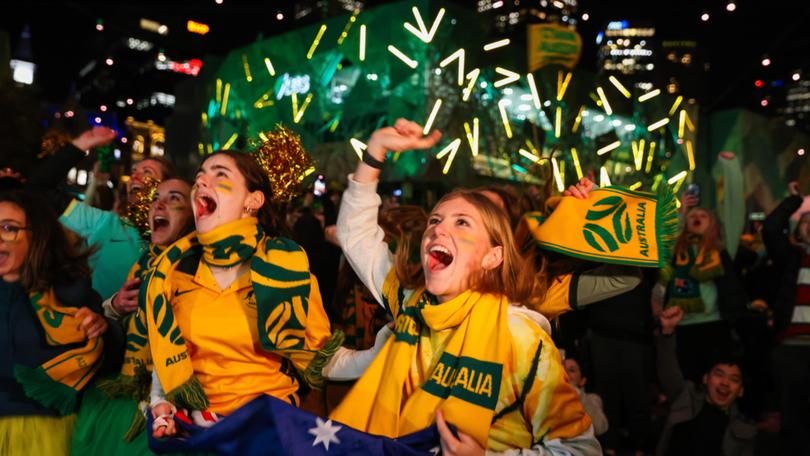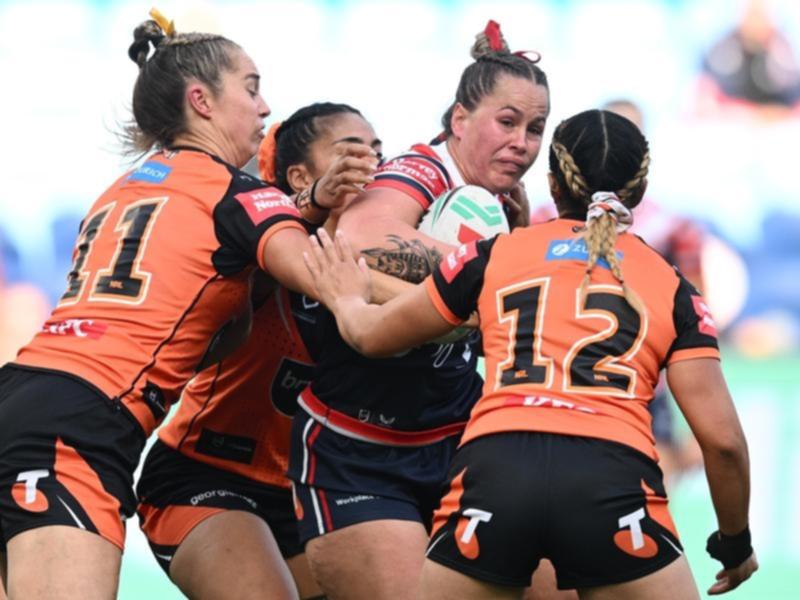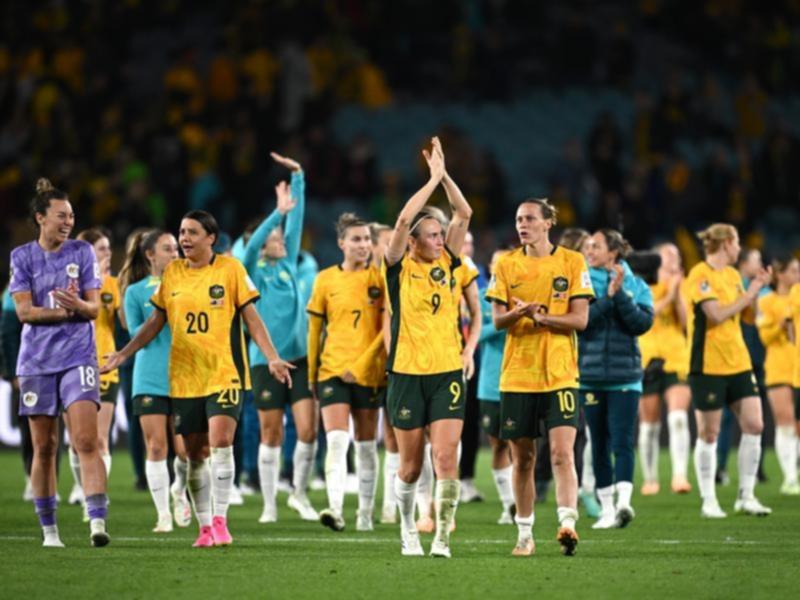Justin Langer: Matildas’ success is changing women’s sport forever but there are still many hurdles

On Monday night I watched the Matildas beat Denmark 2-O from the comfort of my Hamilton Island hotel room.
What a performance. And, what a spectacle - 75,784 adoring fans going mad for an Australian team that is currently the talk of the town.
Not only was it the highest football (soccer) attendance in Australian history but it was also one of the biggest crowds of all time. Not since the Australian women’s cricket team won the ICC Women’s T20 World Cup Final in front of 86,174 at the MCG, has there been such an extraordinary exhibition of women’s sport in this country.
Sign up to The Nightly's newsletters.
Get the first look at the digital newspaper, curated daily stories and breaking headlines delivered to your inbox.
By continuing you agree to our Terms and Privacy Policy.
What’s phenomenal is that the Matildas’ game was still a qualifying fixture. Imagine if our women can advance to the semifinal by beating France today. The mind boggles at just how big this event could be for Australian sport, let alone soccer.
Back on Hamilton Island, and unfortunately, I was only there for a 24-hour visit, to present at a conference. Not only was I enthralled by the contest on Monday night, but I was intrigued by the reaction of so many Australians the next day.
At breakfast, half a dozen strangers asked me if I had watched the Matildas the night before. When I replied in the affirmative, they all wanted to talk to me about the game, and its stars.
A couple of hours later when I mentioned the Matildas as a part of my introduction for my speaking engagement, the room of about 700 people erupted with applause and adulation.
Later that day, while sitting at the airport, I was greeted by similar responses. If nothing else, it was just really cool to see the continued explosion of women’s sport at home and across the globe.
Truthfully, it’s no wonder these reactions played out as they did. More than 6.54 million people watched the Matildas on the Seven Network on Monday night. Putting that into perspective, it outrated five of the past seven AFL grand finals and every NRL grand final and State of Origin since 2016.
It also toppled every major reality show, becoming the highest audience for any television show so far in 2023.
All this on a Monday night and not even a final.
Much as I loved the competitiveness and skill of the Matildas that night, I realise there is something bigger playing out here. The numbers alone highlight to me the flood of momentum building in women’s sport today. This is not only entertaining now, but it signals massive growth into the future.
Driving home from the airport that night I tuned into the radio. During the segment, they weren’t talking about soccer, but rather about the phenomenally successful Barbie movie.
I learned that night that Barbie had broken the US$1 billion mark since its debut just three weeks ago. I also learned that director Greta Gerwig had become the first female filmmaker to surpass the billion-dollar benchmark as a solo director.

As a proud father of four daughters, by the time I drove into my driveway, I couldn’t help but smile about girl power being on fire. How good is that? First the Matildas, Sam Kerr and Co, then Barbie and Margot Robbie, Greta Gerwig and Co. All in one day. Bloody brilliant.
The Barbie slogans that ran from 1984 to 1992, “We Girls Can Do Anything” and “Be Who You Wanna Be” could be mistaken for leading mottos in any international sporting campaign. The current “You Can Be Anything” cements the aspirational and inspirational branding of empowerment being associated with the Barbie brand.
The Matildas, the Australian Women’s Cricket Team, the Australian Women’s Rugby Sevens Team, and the Australian netball team are a few examples of Australian women’s sports teams that have achieved remarkable success over the last few years.
Through elite performance, they have garnered attention and admiration for their accomplishments. Their success reflects the dedication and skill of the athletes, some of whom are doing it for little financial reward.
It is also reflective of the growing support for women’s sports in Australia. Our history is littered with individual superstar women, but today, it is the wave of support for women’s sport in general that carries the most weight.
Sports like AFLW and NRLW are on the rise and while they are yet to reach the heights of some of the other sports, I believe they are only a generation away from becoming a pivotal part of our community.
A couple of weeks ago I was fortunate to share lunch with West Coast Eagles AFLW leadership group. During lunch, we talked about some of the challenges facing women’s sports in Australia.
These include unequal pay and funding compared to men’s sports. This can lead to less-than-ideal professional training environments. Limited media coverage and lower visibility affect this dilemma. Additionally, outdated stereotypes and gender biases have impacted perceptions of women’s sports.
It is obvious this is changing.
Equal investment, representation, and changing societal attitudes are benefiting and being encouraged by nights like last Monday.
The great ambassadors, the heroes on the field, who are simply doing what they love doing best, playing the game, are taking the game to the moon. The broadcasters and sponsors will be watching closely.

This is where the funding comes from. As we all know money doesn’t grow like oranges and lemons on a citrus tree.
That is why success at the highest level is crucial for the growth of sport.
Interest brings money, and dollars enable opportunity.
Considering it was not that long ago that many girls couldn’t have even dreamed of the sporting opportunities available today, let alone reaching the heights of the Matildas, Diamonds or Australian cricket women’s team, the growth is fabulous, and the rewards will follow. There is enough evidence to suggest the rewards are not only following but have now arrived.
And it needs to keep arriving and blossoming.
What is interesting, is that with the rise of women’s sport, the facilities, resources, and infrastructure required to support this growth becomes problematic. Not because it is women’s sport, but because there are now double the requirements. Where there was once a need for boys and men, with a sprinkling of girls and women playing, this is no longer the case.
Discussion regularly arises about the lack of opportunities for female athletes compared to those for male athletes, but the truth is, like money in professional games, it is expensive to increase the infrastructure required to facilitate the increase in numbers for both males and females. More participants mean more resources and infrastructure. These don’t appear out of thin air.
This is a universal headache for administrators, coaches, players and governments all trying their best to accommodate everyone’s needs.
Another challenge is that it costs a lot of money to run high-standard competitions to ensure the level of performance remains high. What we enjoy with the Matildas and Australian cricket team is the product of athletes playing in well-funded competitions internationally and domestically.
Many countries, states and regions simply don’t have the resources to maintain elite competitions. Without elite competition, it is difficult for their charges to compete.
In cricket for example, I know an even playing field will be hard to maintain because competing countries simply can’t afford to accommodate the required rate of competition and professionalism. The risk of this is that the talent gap widens.
There is no doubt this is happening in men’s international cricket, and it is a concern to all involved.
The richer countries are improving, the others are keeping their heads above water and doing their best with what they have.
The gap is widening fast, and the international game is suffering because of this inequality in resources.

Already Seven’s coverage of the FIFA Women’s World Cup 2023™ has reached 9.25 million viewers plus another 1.67 million on its streaming channel 7Plus.
This afternoon’s quarterfinal, according to Seven’s executive producer of Sport Chris Jones, will be “epic”.
When expert commentator Grace Gill teams up with the voice of Australian sport Bruce McAvaney, and soccer tragic Mel McLaughlin today in Brisbane, we can expect sports lovers to be on the edge of their seats.
Regardless of the result, the Matildas have created a legacy, not only in the present but for girls around the country who could one day enjoy the spoils of the talented, tough and ambitious young women who are paving a highway of opportunity for the next generation of aspiring sports stars.
Women’s sport is not creating a pathway, but rather a superhighway. Let’s hope we have the materials and means to support this exciting new world.
